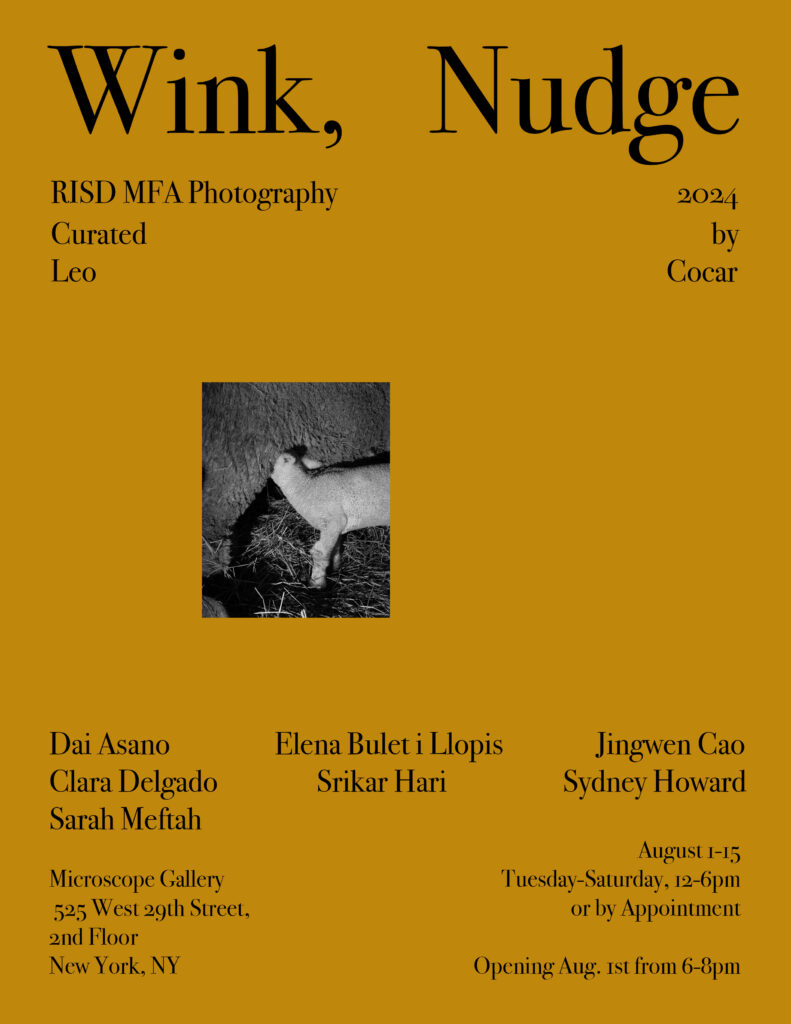Wink, Nudge
RISD MFA Photography Class of 2024
August 1-15, 2024
Opening Thursday August 1, 6-8pm

Microscope Gallery is pleased to host Wink, Nudge, a group exhibition of new work by the Rhode Island School of Design MFA Photography Class of 2024: Dai Asano, Elena Bulet i Llopis, Jingwen Cao, Clara Delgado, Srikar Hari, Sydney Howard and Sarah Meftah. Curated by Leo Cocar.
Leo Cocar is a guest and cultural worker from the unceded territories of the xwməθkwəy̓əm (Musqueam), Skwxwú7mesh (Squamish), and Səl̓ílwətaʔ/Selilwitulh (Tsleil-Waututh) First Nations. His writing has appeared in Bomb, e-flux, C Magazine, Momus, Autre, and Numéro Berlin, among others. He is currently organizing a solo exhibition of the work of Derya Akay at the Fall River Museum of Contemporary Art and developing a long-term research project about the Ultimate Fighting Championship.
From the curator:
“What is fundamentally at play in the work here at Wink, Nudge is an eschewment of any possibility of the camera’s ability to capture reality as such. It has long since passed that we have come to understand that the photographic apparatus is not that which re-presents the objective but translates, or mediates, a subjectivity. These artists – Dai Asano, Sarah Meftah, Sydney Howard, Srikar Hari, Clara Delgado, Elena Bulet i Llopis, and Jingwen Cao – acknowledge, through ways implicit and explicit, photography’s failure to capture the so-called real. The work here, however, is not an act of capitulation to this breakdown; it is fundamentally an attempt to recapture this sense of reality. This is not reality in the sense of natural forms but rather the structures and relations that underpin the world – that which is nearly unrepresentable but nonetheless forms the undergirding of human experience.
Certainly it is this mode (that of photography’s failure to image the real) that comes to the fore here in this exhibition. Although this understanding may seem old hat within an art historical context, the clinging onto the myth of the photograph as an almost scientifically objective medium continues to haunt the collective psyche; in an age when both the camera (via the phone) and the ability to propagate said imagery (via the internet) have become ubiquitous, images and photographs have become locked in a tense state of contestation in which every image attempts to assert its subjectivity as the objective. For this reason alone, the continued inquiry into the failures and successes of the camera’s ability to image the world remain prescient, and perhaps, even more than ever, since the medium’s inception.
These artists have approached the medium from a myriad of angles, from the addition of sculptures or non photographic materials that break the image out of itself to a focus on the structures and conditions that contextualize image culture itself. The artists here approach the medium from several vantage points, punctuated by moments of overlap. The likes of Sydney Howard and Elena Bulet i Llopis take up familial histories as their point of departure, but through abstraction and suggestion open up this inquiry from the particular of the family to the general of the psyche, memory, and the slipfalls of historicization. In others, aect and feel act as conceptual anchors. In Clara Delgado’s work, she attempts the task of distilling in the still image the passage of time, travel, and in-betweenness; a space between movement and stasis. This focus on feel also bubbles to the surface in Sarah Meftah’s work in which she takes up the task of instilling an uncanny strangeness into the loaded symbol of the American home and all the psycho-social baggage that forms its architecture. This interest in photography and psychology also comes into the conversation of Jingwen Cao’s work through the production of almost banal imagery of liminal spaces whose ur-text quality underscores the relationship between viewer and image, posing questions regarding how the image travels and how value surrounding it is formed. In others, the apparatus itself becomes the focus. Srikar’s sculpture-cum-image works, in which the viewer views themselves through a temporally delayed video feedback, the artist not only lays bare the ways in which images are produced in the digital age, but calls to attention the ways in which the image produces ideas of the self. Temporality is particularly pushed to the fore in Dai Asano’s videos, in which, through durational performance, the artists delays, stalls, and expands the interstitial quality of waiting and passage.
Photography is ultimately a dialectical process, a dyad of a structural limitation in which something must be imaged and the artist’s own intervention via thought, idea, and concept can provide the tool with which to. When this tension is picked-at in just the right manner, a synthesis is formed in which the photograph begins to image what lies beyond the frame. Here, the play with photography’s structural limitations is one that is inherently productive – through the refusal of the myth of the camera as that which can show us reality in its totality by turning to the fact that it can only show us the world in granular, fleeting moments, the work here takes on a poetic, open, and vital quality. As these artists demonstrate, the gesture which points outwards towards the ineffable need not be monumental – merely a wink, a nudge.” — Leo Cocar
